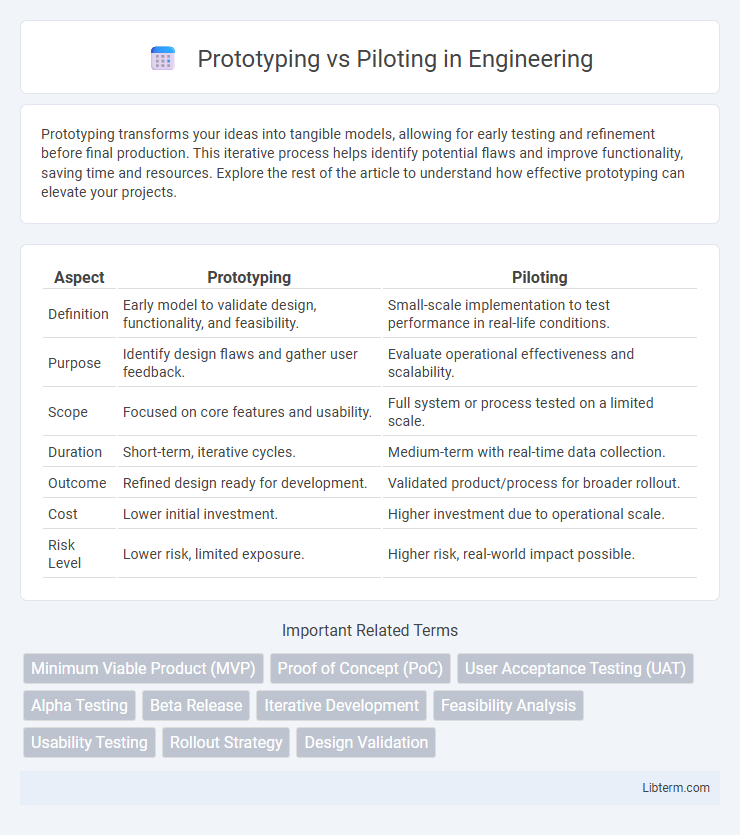Prototyping transforms your ideas into tangible models, allowing for early testing and refinement before final production. This iterative process helps identify potential flaws and improve functionality, saving time and resources. Explore the rest of the article to understand how effective prototyping can elevate your projects.
Table of Comparison
| Aspect | Prototyping | Piloting |
|---|---|---|
| Definition | Early model to validate design, functionality, and feasibility. | Small-scale implementation to test performance in real-life conditions. |
| Purpose | Identify design flaws and gather user feedback. | Evaluate operational effectiveness and scalability. |
| Scope | Focused on core features and usability. | Full system or process tested on a limited scale. |
| Duration | Short-term, iterative cycles. | Medium-term with real-time data collection. |
| Outcome | Refined design ready for development. | Validated product/process for broader rollout. |
| Cost | Lower initial investment. | Higher investment due to operational scale. |
| Risk Level | Lower risk, limited exposure. | Higher risk, real-world impact possible. |
Introduction to Prototyping and Piloting
Prototyping involves creating an early model of a product to test concepts and gather user feedback, enabling iterative design improvements before full-scale development. Piloting refers to implementing a limited version of a product or service in a real-world environment to evaluate performance, usability, and potential issues in a controlled setting. Both processes are critical in product development, with prototyping focusing on design validation and piloting emphasizing operational testing.
Defining Prototyping: Purpose and Process
Prototyping serves as an early-stage process in product development designed to visualize and validate concepts through tangible models or simulations, enabling stakeholders to explore functionality and design before full-scale production. Its purpose centers on identifying usability issues, gathering user feedback, and refining features iteratively to align the solution with user needs and technical feasibility. The process involves rapid creation, testing, and modification cycles, often employing low-fidelity prototypes to reduce cost and time in assessing core ideas and potential improvements.
Understanding Piloting: Goals and Methodology
Piloting aims to evaluate a solution's performance in a real-world environment to identify potential issues and validate effectiveness before full-scale implementation. This methodology involves selecting a representative segment of the target audience or system, deploying the solution under typical conditions, and collecting quantitative and qualitative data to measure outcomes against predefined success criteria. The goal is to minimize risks, optimize operational workflows, and ensure scalability by iteratively refining the solution based on pilot feedback.
Key Differences Between Prototyping and Piloting
Prototyping involves creating an early, often low-fidelity model of a product or system to test design concepts and gather user feedback, primarily focusing on functionality and usability. Piloting, on the other hand, is the implementation of a near-final product or process in a real-world environment to evaluate performance, operational feasibility, and identify potential issues before full-scale deployment. Key differences include the development stage, with prototyping occurring in the conceptual phase and piloting in the pre-launch phase, as well as the scope, where prototyping tests design hypotheses and piloting tests practical application.
When to Use Prototyping vs Piloting
Prototyping is ideal during the early product development stage when testing design concepts, usability, and functionality with a small group to gather feedback and identify improvements. Piloting is used after prototyping, involving a controlled rollout of the near-final product to a limited audience to assess performance, operational feasibility, and user acceptance in real-world conditions. Choosing between prototyping and piloting depends on whether the goal is conceptual validation or implementation testing before full-scale launch.
Benefits of Prototyping in Product Development
Prototyping accelerates product development by enabling early detection of design flaws and user experience issues, reducing costly revisions in later stages. It promotes iterative testing and stakeholder feedback, which enhances product functionality and alignment with market needs. This hands-on approach increases collaboration among cross-functional teams, fostering innovation and ensuring a more refined, viable product before full-scale production.
Advantages of Piloting for Market Validation
Piloting offers key advantages for market validation by providing real-world customer feedback that helps refine products before full-scale launch. It reduces financial risks through controlled testing and uncovers unforeseen market challenges, enabling data-driven decisions. Pilot programs enhance stakeholder confidence by demonstrating product viability and user acceptance in authentic market conditions.
Common Challenges in Prototyping and Piloting
Common challenges in prototyping include limited resource allocation, incomplete user feedback, and difficulty in replicating real-world conditions, which can lead to misleading performance insights. Piloting often faces obstacles such as scalability issues, integration with existing systems, and managing user adoption across diverse environments. Both stages struggle with balancing speed and thoroughness to ensure viable, impactful results without excessive cost or delay.
Case Studies: Successful Prototyping and Piloting
Case studies highlight that successful prototyping often involves rapid iteration to refine product features based on real user feedback, accelerating innovation cycles and reducing time-to-market. In piloting, companies validate operational workflows and scalability by deploying solutions in controlled environments, exemplified by tech firms using pilot programs to assess infrastructure before full-scale launch. These examples demonstrate how prototyping sharpens product viability while piloting ensures robust implementation, both critical in reducing risks and optimizing resource allocation.
Conclusion: Choosing the Right Approach
Selecting between prototyping and piloting depends on project goals, resource availability, and risk tolerance. Prototyping excels in early-stage idea validation and design refinement, while piloting is ideal for testing full-scale implementation in real-world conditions. Effective decision-making involves balancing speed, feedback quality, and scalability to align with organizational objectives.
Prototyping Infographic

 libterm.com
libterm.com